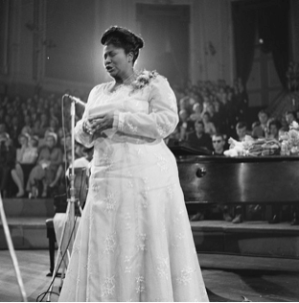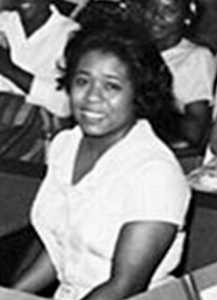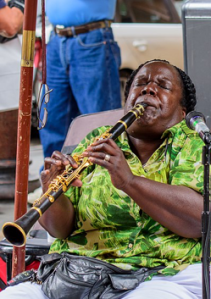Three Women Who Made New Orleans Music History
Visitors to New Orleans hear all about Louis Armstrong, Buddy Bolden, Jelly Roll Morton, and the other innovative musicians who made New Orleans the birthplace of jazz. But have you noticed that the usual list of jazz luminaries is a bit of an Andouille-sausage fest?
This Women’s History Month, we’re setting the record straight and bringing you three of the Big Easy’s most essential women musicians, without whom New Orleans wouldn’t be the jazz mecca that it is today.
The Queen of Gospel

Image: Mahalia Jackson in Concert, from Wikimedia Commons (April 23, 1961)
Born into poverty in New Orleans’s Sixteenth Ward, Mahalia Jackson (1911-1972) rose to become the first gospel singer to achieve mainstream success, an international sensation, the godmother of rock-and-roll, and a Civil Rights icon.
Despite her unmatched talent, Jackson was an unlikely superstar. She was raised in a devout Baptist household that shunned the rowdy clubs where jazz was invented and mostly stuck to traditional hymns at church.
Yet next door to the Water Street shotgun house where she lived was a Pentecostal church, and it was by eavesdropping that Jackson first experienced the power of gospel music. Her newfound love of gospel blossomed, and soon she was sneaking listens records by Bessie Smith, Ma Rainey, and Mamie Smith. As the grandchild of enslaved people, Jackson felt that gospel music connected her with her past. “They had a beat, a rhythm we held on to from slavery days,” she once said.
As her singing career took off in the 1930s and 1940s, Jackson remained a champion of racial equality and insisted on having integrated seating at her concerts. In 1956, she met Martin Luther King, Jr., and she soon become a fixture at Civil Rights rallies, performing at the Montgomery Bus Boycott, the March on Washington, and King’s funeral. Jackson later became the first American artist to perform in Japan after WWII and also toured India, Europe, and Africa. She permanently returned to New Orleans in 1968 and remained here until her death in 1972. More than 60,000 passed her casket as she lay in state in Rivergate Auditorium—a final reminder of Mahalia Jackson’s success at bringing people together through gospel music.
A Legend in the Classroom

Image: Yvonne Busch, from Wikipedia (1962)
A native of the Ninth Ward who moved to the music-filled Tremé neighborhood as an infant, Yvonne Busch (1929-2014) was an obscure musician who nevertheless trained dozens of New Orleans’s most famous jazz all-stars.
Busch was a child prodigy who could teach herself any instrument that she touched, but trumpet was her horn of choice. By the age of 12, Busch had begun performing with orchestras like the International Sweethearts of Rhythm and the Swinging Rays of Rhythm. She went on to become the only female member of Southern University’s jazz band, and for a time, Busch seemed destined to break into jazz world as Louis Armstrong’s heir apparent.
But Busch’s passion was for spreading her love of music to New Orleans’s youngsters. After obtaining her teaching degree, Busch returned to NOLA in 1951 and, for the next 32 years, taught music at public high schools. Busch performed occasionally and even played with William Houston’s famed big band for a short time, but she concentrated most of her efforts on training the next generation of jazz greats. Many of her former students went on to enjoy professional careers, including Smokey Johnson, James Crawford, Herlin Riley, John Boudreaux, James Black, Nat Perrilliat, James Rivers, Sugar Boy Crawford, and Sullivan Dabney. Without Busch’s tireless dedication to music education, NOLA’s jazz scene surely would be nowhere near as vibrant as it is today.
The Lady Louis
No one—and I mean no one—blows a clarinet like Doreen Ketchens (1966—). Her ability to hit forceful high notes has rightfully earned her the nickname “The Lady Louis,” and she is a titan among NOLA’s contemporary jazz musicians.

Image: Doreen Ketchens, by David Kabot, Wikimedia Commons (April 28, 2016)
Ketchens showed little interest in music until the 5th grade, when she signed up for the school band to get out of a pop quiz. While the flute was her first choice of instrument, she was late to enroll and all of the flute positions were filled. Clarinet was her fallback, and her talent soon became obvious. A few years later, Ketchens was welcomed into NOLA’s legendary Center for the Creative Arts, the training ground for other virtuosos including Wynton Marsalis, Harry Connick, Jr., and Jon Batiste.
By the 1980s, Ketchens could be heard performing on street corners and in clubs around NOLA. Breaking from tradition at a time when jazz remained male dominated and had few female bandleaders, Doreen’s New Orleans Jazz Band, as her group was known, was all about her talent on the clarinet. They quickly became a staple of the city’s busking circuit and can frequently be heard performing at the corner of Royal and St. Peter.
Looking for More?
If you want to learn more about New Orleans’s women musicians, don’t miss the Jazz & Heritage Foundation’s 4th annual “Chanteuse” concert series, celebrating New Orleans women in music. The series only continues throughout the first few weekends in March, so don’t delay!
